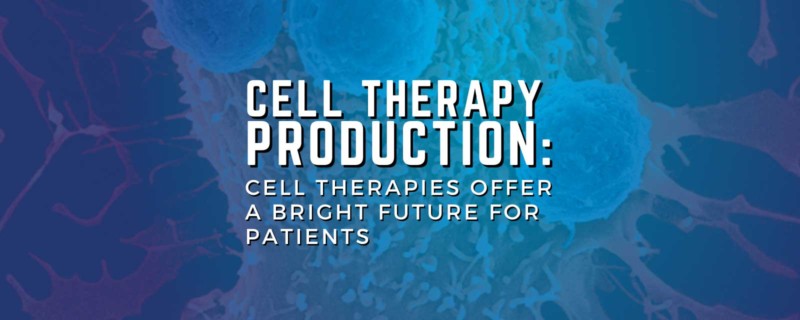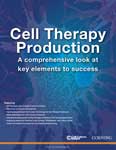
Cell Therapies Offer A Bright Future for Patients
 This article is the first in a series that was published in the eBook
This article is the first in a series that was published in the eBook“Cell Therapy Production”.
You can download all the articles in the series, by downloading the eBook.
Cell therapies offer tremendous potential to treat, and in some instances, cure diseases for which there is often no treatment available. The term cell therapy encompasses several different types of therapeutics. Cell therapies have a variety of modalities and use different cell types, have different manufacturing protocols, and treat different diseases. Thus, the production of a cell therapy is complex, with manufacturing technologies and procedures still evolving to meet these unique needs. In this publication, we aim to provide an overview of key considerations for cell therapy production, technologies that are being developed and employed, and ultimately how a therapeutic candidate moves from research scale to clinical or commercial manufacturing.
Industry Outlook
The global cell therapy market is strong and continues to increase. Market research predicts an annual growth rate of 5.4% reaching USD 8.83 billion by 2027. This unprecedented growth is attributed to new cell therapy product approvals, expansion of approved indications for current products, as well as increasing awareness, acceptance, and use of these advanced biological products globally.
Cell and gene therapies continue to progress through the clinical pipeline with the highest number of ongoing clinical trials to date, 1,220 worldwide1. This market growth coupled with impressive clinical results and recent regulatory approvals has driven an increase in demand for manufacturing solutions.

Indications
Cell therapies have been getting a great deal of attention as of late—most notably, gene-modified cell therapies for cancer immunology, such as CAR T therapies. In fact, the American Society of Clinical Oncology’s (ASCO) Clinical Cancer Advances 2018 report named adoptive immunotherapy with chimeric antigen receptor T cells (CAR T) as the most important clinical cancer advancement of the year. The largest indication for cell therapy is oncology, followed by indications for the central nervous system2.
Recent approvals in the CAR T space have driven both research and investment. In 2020, the FDA approved Kite’s CAR-T therapy, Tecartus, for patients with relapsed or refractory (R/R) mantle cell lymphoma. Results in patients have been groundbreaking, with a nearly 90% response rate1. In February 2021, the FDA approved Bristol Myers Squibb’s CAR-T therapy, Breyanzi, for the treatment of diffuse large B-cell lymphoma. Breyanzi was the first therapy approved under the FDA’s Regenerative Medicine Advanced Therapy (RMAT) Designation. RMAT designation facilitates the expeditious development of regenerative medicine therapies intended for serious conditions.
Cell Therapy Manufacturing
Efficient manufacturing is a critical aspect of determining whether a cell therapy will be commercialized or not. Including process development and manufacturing plans early in product development to ensure speed-to-market and commercial feasibility is important to success. In addition, if a cell therapy is designated under a regulatory expedited timeline, this will impact development timelines and needs to be considered during process design and scale-up.
Autologous vs. Allogeneic
Autologous therapies are examples of personalized medicine. They use a patient’s own cells as the starting point and are manufactured as a single lot per patient. Autologous scale up is frequently referred to as “scaling out” because manufacturing requires the production of many small lots of individual products manufactured at the same time.
Allogeneic therapies on the other hand are manufactured in large lots from unrelated donor tissue. Allogeneic therapies are considered “off the shelf” in that it is one product used to treat many patients. These therapies require scale up by increasing the manufacturing vessel volume.
Process Development
The goal of process development is to reach a robust biomanufacturing process with efficiency gains, consistency, cost reduction, maintenance of quality and safety attributes, and overall risk reduction as additional key objectives. Although speed-to-market initiatives have condensed already tight timelines, process development is a crucial intermediate step
between research and commercial manufacturing. The success of producing a robust and cost-effective cell product at a scale that can meet patient needs is built upon the optimization achieved during process development. While the individual process steps can vary, the general cellular therapy workflow includes upstream and downstream unit operations such as cell isolation, cell culture media optimization, cell expansion, modification, purification, and characterization.
Media Optimization
In cell-based therapies, the cultured cells are the therapeutic product, which necessitates cell culture media optimization to meet growth and productivity targets for cell production. Off-the-shelf media solutions can provide a fast and efficient solution in early development, but there are some specific scale-up conditions that are difficult to meet with off-the-shelf media. Moving from small-scale, small volume static cultures to large-scale, large volume vessels trigger a host of additional requirements that cannot be easily addressed with an off-the-shelf solution. Thus, media development and optimization is important to successful clinical and commercial manufacturing. Often, partnering with a contract media manufacturer can provide the experience and support needed for a successful transition from lab to commercial scale media.

Scalability
Scale is one of the biggest considerations when designing the manufacturing process. This can be a challenge to achieve, particularly if a product’s approval timeline is accelerated. Determining how to scale-up or scale-out means identifying how much material is needed for the therapeutic being manufactured. Because the cells are the therapeutic product, they need to retain their phenotype and functionality regardless of the manufacturing method.
Allogeneic therapies fit into a more traditional, centralized manufacturing model, where one therapeutic batch can treat many patients. In contrast, autologous therapies necessitate a de-centralized model, where manufacturing occurs near the point of care due to the patient-specific nature of the therapy. Here, one patient equals one manufacturing batch, which limits batch volumes and associated economies of scale at that level.
Aseptic Processing and Closed Systems
Aseptic processing is stated as “Handling sterile materials in a controlled environment, in which the air supply, facility, materials, equipment and personnel are regulated to control microbial and particulate contamination to acceptable levels.”3 Aseptic controls are important in cell therapy production as there are typically more open operations in these processes when compared to traditional protein based biologics, thus the risk of contamination is greater. In addition, with cell therapies, commonly used viral clearance and sterile filtration methods are not possible, as the cell is the therapy.4
A truly closed system with no environmental exposure eliminates the risk of contaminants, but the nature of certain process steps in cell therapy production may not currently be achievable in a closed system manner. As such, a “functionally closed system” allows users to perform unit operations in a realistic and logical but safe manner.
In Closing
Cell therapies offer a tremendous opportunity to increase our medicinal arsenal, but there are manufacturing challenges and solutions are evolving. Suppliers are creating innovative, fit for purpose products to solve the unique challenges that cell therapy products present. In this publication, we will discuss current solutions and also future opportunities for improvement.
Footnotes
-
1. Alliance for Regenerative Medicine. Advancing gene, cell, & tissue-Based Therapies-ARM annual report & sector year in review: 2019. Accessed Oct. 11, 2020: Retrieved from www.alliancerm.org/sector-report/2019-annual-report/
-
2. Alliance for Regenerative Medicine. Growth & Resilience in Regenerative Medicines: 2020. Accessed May 1, 2021: Retrieved from alliancerm.org/ sector-report/2020-annual-report/
-
3. Parenteral Drug Association (2011). Process simulation for aseptically filled products PDA task force-2011. Accessed Oct. 11, 2020: Retrieved from store. pda.org/ TableOfContents/TR2211_TOC.pdf
-
4. Barone, P. W. et al. Viral contamination in biologic manufacture and implications for emerging therapies. Nat Biotechnol 38, 563-572 (2020).